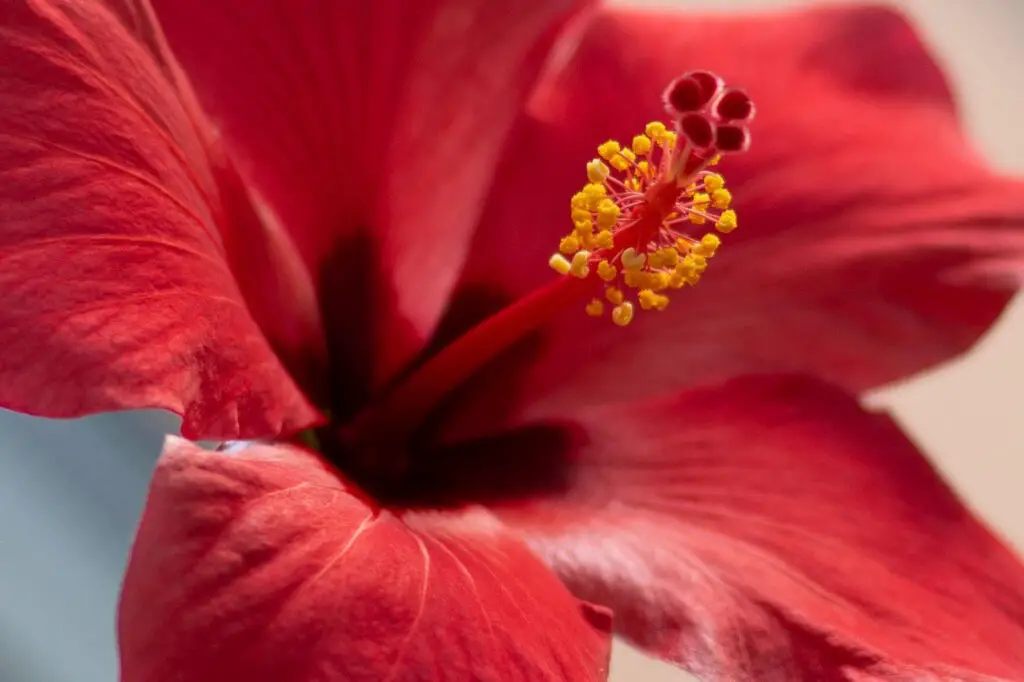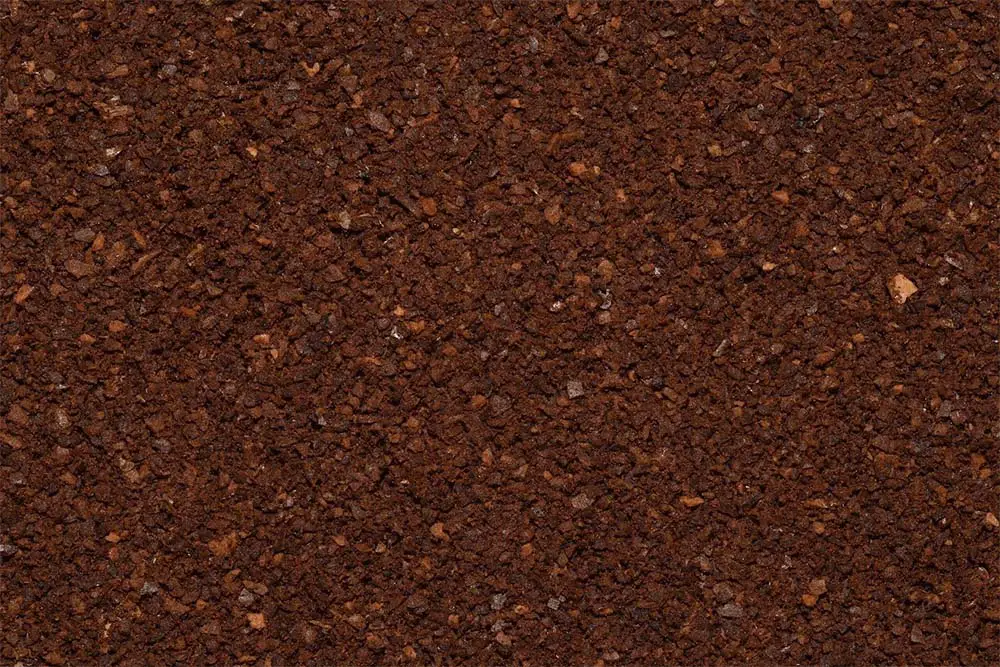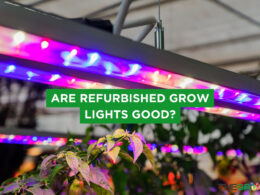In This Article Show
If you’re a gardener, you know that the key to keeping your plants healthy and happy is providing them with the right environment and care. One way to do this is by using coffee grounds in your garden; hibiscus plants are no exception.
Hibiscus plants love coffee grounds! But before we dive into how and when to use coffee grounds for hibiscus, let’s first look at this beautiful and versatile flowering plant.
Yes, hibiscus likes coffee grounds as it has been discovered to provide this flower with many benefits. Coffee grounds can be great fertilizer for hibiscus. Since it’s a tropical plant that does best in well-drained soil, coffee grounds can provide nitrogen and potassium that serves as fertilizer.
Pictured Above: A vibrant red hibiscus flower with large, ruffled petals and a dark center, set against a blurred grey background.

Hibiscus Flowers Explained
The hibiscus plant is a herbaceous flowering perennial. The genus Hibiscus, belonging to the mallow family (Malvaceae), comprises several hundred species, which can be found in warm temperate, subtropical, and tropical regions worldwide (Linnaeus and Black, 2022).
The hibiscus plant is known for its large, showy flowers in various colors, such as red, pink, orange, yellow, and white. Hibiscus plants are available in multiple sizes and types, from small shrubs to large trees. There are many different varieties of hibiscus, including:
Get Gardening For Beginners
Our new EBOOK shows newcomers and green thumbs alike a step by step guide to growing the garden of their dreams.
- Chinese hibiscus (Hibiscus rosa-sinensis)
- Rose of Sharon (Hibiscus syriacus)
- Hawaiian hibiscus (Hibiscus Brackenridge)
- Confederate rose (Hibiscus mutabilis)
- Great Red Hibiscus (Hibiscus coccineus).
I am growing the Great Red Hibiscus in my US garden in Washington State, a cold, hardy variety. Be sure to choose a variety that best suits your climate and growing conditions.
Almost all hibiscus plants prefer well-drained soil rich in organic matter and thrives in slightly acidic soil with a pH between 5.5 and 7.0 (Linnaeus and Black, 2022). This is where coffee grounds come in – adding coffee grounds to hibiscus soil can help to improve the soil’s acidity and provide essential nutrients like nitrogen, phosphorus, and potassium.
How to Add Coffee Grounds to Hibiscus Soil
Adding coffee grounds to hibiscus soil is easy. Simply follow the below instructions:
- Sprinkle a thin layer of coffee grounds around the base of the plant, and then work the coffee grounds into the soil.
- Be sure not to add too many at once and mix well.
- Add new coffee grounds every 2-3 months during the growing season, especially during spring and fall, as the plant is actively growing.
Additionally, you can mix the coffee grounds with many other kinds of organic matter to add a rich layer to the soil. In the past, I have mixed coffee grounds with compost, leaf mold, manure, biochar, straw, and grass clippings.
This gives the hibiscus (and many other plants in the garden) a set of diverse, balanced nutrients. I also made a liquid fertilizer by steeping the coffee grounds in water for a few days and then pouring the liquid around the base of the plant.
However, if practicing this method, use it in moderation (not more than once or twice per year), as too much liquid too frequently can lead to a nutrient imbalance.
Can You Add Too Many Coffee Grounds to Hibiscus Soil?
When adding coffee grounds to the base of a Hibiscus plant (or any plant), remember that balance is key. While coffee grounds can provide many benefits to your hibiscus plants, such as improving the soil’s acidity and providing important nutrients, it is possible to add too many coffee grounds to the soil.
Get Gardening For Beginners
Our new EBOOK shows newcomers and green thumbs alike a step by step guide to growing the garden of their dreams.
Excessive amounts can make the soil too acidic, leading to nutrient deficiencies and other problems for your hibiscus plants. For example, the hibiscus’s roots will not be able to absorb essential nutrients like phosphorus and potassium, which can lead to stunted growth and poor flower production.
Additionally, too much acidity in the soil can make it harder for the plant to absorb water, leading to root rot.
Pictured above: A close-up photograph of medium-dark, coarse coffee grounds, with a few small, dry pieces of coffee beans visible among them.
As a general rule of thumb, add a thin layer of coffee grounds around the base of the plant, no more than an inch thick. The more organic matter you can mix with the coffee grounds, the better.
Test the pH of the soil around your hibiscus plant incrementally with a pH meter, and if it is below 5.5, amend your soil with lime or other alkaline materials such as straw or grass clippings. If your soil is too acidic, use minimal coffee grounds when fertilizing.

Hibiscus and Coffee Grounds: The Perfect Match
Coffee grounds can be a great addition to hibiscus soil by providing essential nutrients and improving the soil’s acidity, not to mention a great reuse of a common household item that would typically go to waste.
However, using coffee grounds in moderation is important to avoid making the soil too acidic and causing problems for your hibiscus plants. By regularly testing the soil’s pH and adding a thin layer of coffee grounds around the base of the plant, you can enjoy beautiful, healthy hibiscus plants in your garden.
With some care, your hibiscus plants will thrive and reward you with stunning blooms.
References
- Linnaeus, Carl, and Cindy Black. “Hibiscus History.” Hidden Valley Hibiscus, https://www.hiddenvalleyhibiscus.com/history/earlyhistory.htm 2022. Accessed 26 January 2023.
- Linnaeus, Carl, and Cindy Black. “High pH & Alkalinity.” Hidden Valley Hibiscus, https://www.hiddenvalleyhibiscus.com/images/alkalinity.htm 2022. Accessed 26 January 2023.










